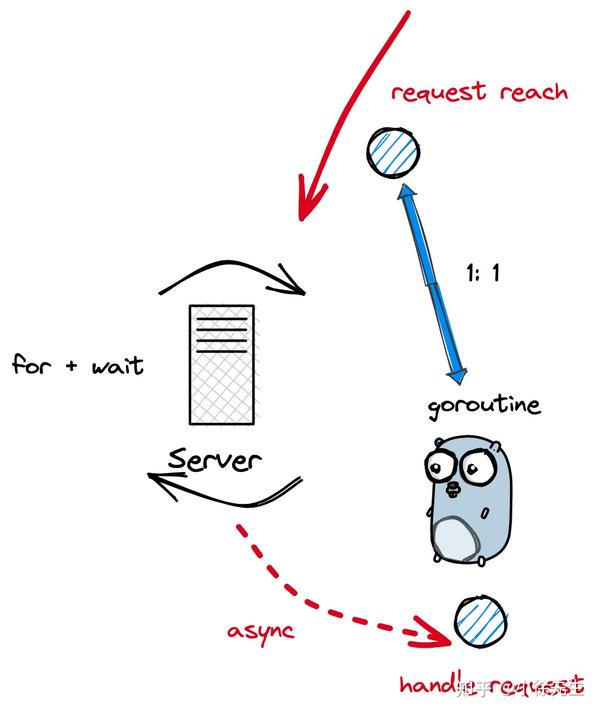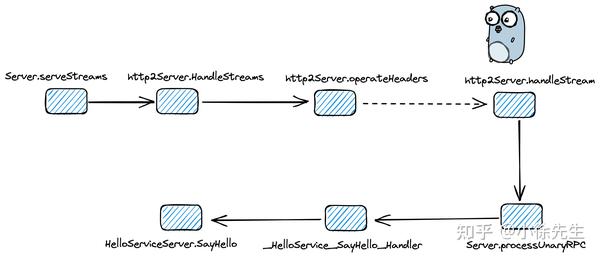grpc.md
概述
protoc
安装
1 | |
使用
编写 proto 文件
1 | |
该文件以 .proto 作为后缀,扮演着 grpc 客户端与服务端通信交互的接口定义语言(DDL)的角色.
protobuf 的细节内容与底层原理,后续我们单开章节再作介绍,此处能理解其基本用法即可.
上述内容中,抛开前置的固定语法标识外,分为三个核心部分:
定义业务处理服务 HelloService,声明业务方法的名称(SayHello)以及出入参协议(HelloReq/HelloResp)
遵循 protobuf 的风格,分别声明出入参的类型定义:HelloReq 和 HelloResp,其中分别包含了字符串类型的成员字段 name 和 reply
生成 pb.go 文件
1 | |
1 | |
上述代码展示了 pb.go 文件中的内容,核心是基于 .proto 定义的出入参协议,生成对应的 golang 类定义代码.
1 | |
上述代码展示了 grpc.pb.go 文件中的内容,核心内容包括:
- 基于 .proto 文件生成了客户端的桩代码,后续作为用户使用 grpc 客户端模块的 sdk 入口.
- 基于 .proto 文件生成了服务端的服务注册桩代码,后续作为用户使用 grpc 服务端模块的 sdk 入口
- 基于 .proto 文件生成了业务处理服务(pb.HelloService)的描述符,每个描述符内部会建立基于方法名(SayHello)到具体处理函数(_
HelloService_SayHello_Handler)的映射关系
服务端启动
1 | |
- 预声明业务处理服务 HelloService,实现好桩文件中定义的业务处理方法 SayHello
- 调用 net.Listen 方法,创建 tcp 端口监听器
- 调用 grpc.NewServer 方法,创建一个 grpc server 对象
- 调用桩文件中预生成好的注册方法 proto.RegisterHelloServiceServer,将 HelloService 注册到 grpc server 对象当中
- 运行 server.Serve 方法,监听指定的端口,真正启动 grpc server
客户端
1 | |
- 调用 grpc.Dial 方法,与指定地址的 grpc 服务端建立连接
- 调用桩文件中的方法 proto.NewHelloServiceClient,创建 pb 文件预声明好的 grpc 客户端对象
- 调用 client.SayHello 方法,发送 grpc 请求,并处理响应结果
3 服务端
3.1 核心数据结构

在 grpc 服务端领域,自上而下有着三个层次分明的结构:server->service->method
- 最高级别是 server,是对整个 grpc 服务端的抽象
- 一个 server 下可以注册挂载多个业务服务 service
- 一个 service 下存在多个业务处理方法 method
(1)server
type Server struct {
// 配置项
opts serverOptions
// 互斥锁保证并发安全
mu sync.Mutex
// tcp 端口监听器池
lis map[net.Listener]bool
// ...
// 连接池
conns map[string]map[transport.ServerTransport]bool
serve bool
cv *sync.Cond
// 业务服务映射管理
services map[string]*serviceInfo // service name -> service info
// ...
serveWG sync.WaitGroup
// ...
}
Server 类是对 grpc 服务端的代码实现,其中通过一个名为 services 的 map,记录了由服务名到具体业务服务模块的映射关系.
(2)serviceInfo
type serviceInfo struct {
// 业务服务类
serviceImpl interface{
// 业务方法映射管理
methods map[string]*MethodDesc
// ...
}
serviceInfo 是某一个具体的业务服务模块,其中通过一个名为 methods 的 map 记录了由方法名到具体方法的映射关系.
(3)MethodDesc
type MethodDesc struct {
MethodName string
Handler methodHandler
}
MethodDesc 是对方法的封装,其中的字段 Handler 是真正的业务处理方法.
(4)methodHandler
type methodHandler func(srv interface{}, ctx context.Context, dec func(interface{}) error, interceptor UnaryServerInterceptor) (interface{}, error)
methodsHandler 是业务处理方法的类型,其中几个关键入参的含义分别是:
- srv:业务处理方法从属的业务服务模块
- dec:进行入参 req 反序列化的闭包函数
- interceptor:业务处理方法外部包裹的拦截器方法
3.2 创建 server
func NewServer(opt ...ServerOption) *Server {
opts := defaultServerOptions
for _, o := range extraServerOptions {
o.apply(&opts)
}
for _, o := range opt {
o.apply(&opts)
}
s := &Server{
lis: make(map[net.Listener]bool),
opts: opts,
conns: make(map[string]map[transport.ServerTransport]bool),
services: make(map[string]*serviceInfo),
quit: grpcsync.NewEvent(),
done: grpcsync.NewEvent(),
czData: new(channelzData),
}
chainUnaryServerInterceptors(s)
//...
s.cv = sync.NewCond(&s.mu)
// ...
return s
}
grpc.NewServer 方法中会创建 server 实例,并调用 chainUnaryServerInterceptors 方法,将一系列拦截器
interceptor 成链,并注入到 ServerOption 当中. 有关拦截器的内容,放在本文第 4 章再作展开.
func chainUnaryServerInterceptors(s *Server) {
interceptors := s.opts.chainUnaryInts
if s.opts.unaryInt != nil {
interceptors = append([]UnaryServerInterceptor{s.opts.unaryInt}, s.opts.chainUnaryInts...)
}
var chainedInt UnaryServerInterceptor
if len(interceptors) == 0 {
chainedInt = nil
} else if len(interceptors) == 1 {
chainedInt = interceptors[0]
} else {
chainedInt = chainUnaryInterceptors(interceptors)
}
s.opts.unaryInt = chainedInt
}
3.3 注册 service

创建好 grpc server 后,接下来通过使用桩代码中预生成好的 RegisterXXXServer 方法,业务处理服务 service 模块注入到
server 当中.
func RegisterHelloServiceServer(s grpc.ServiceRegistrar, srv HelloServiceServer) {
s.RegisterService(&HelloService_ServiceDesc, srv)
}
func (s *Server) RegisterService(sd *ServiceDesc, ss interface{}) {
// ...
s.register(sd, ss)
}
func (s *Server) register(sd *ServiceDesc, ss interface{}) {
s.mu.Lock()
defer s.mu.Unlock()
// ...
info := &serviceInfo{
serviceImpl: ss,
methods: make(map[string]*MethodDesc),
streams: make(map[string]*StreamDesc),
mdata: sd.Metadata,
}
for i := range sd.Methods {
d := &sd.Methods[i]
info.methods[d.MethodName] = d
}
// ...
s.services[sd.ServiceName] = info
}
注册过程会经历 RegisterHelloServiceServer->Server.RegisterService -> Server.register
的调用链路,把 service 的所有方法注册到 serviceInfo 的 methods map 当中,然后将 service 封装到
serviceInfo 实例中,注册到 server 的 services map 当中
3.4 运行 server
func (s *Server) Serve(lis net.Listener) error {
// ...
var tempDelay time.Duration // how long to sleep on accept failure
for {
rawConn, err := lis.Accept()
if err != nil {
// ...
}
// ...
s.serveWG.Add(1)
go func() {
s.handleRawConn(lis.Addr().String(), rawConn)
s.serveWG.Done()
}()
}
}

grpc server 运行的流程,核心是基于 for 循环实现的主动轮询模型,每轮会通过调用 net.Listener.Accept 方法,基于 IO
多路复用 epoll 方式,阻塞等待 grpc 请求的到达.
每当有新的连接到达后,服务端会开启一个 goroutine,调用对应的 Server.handleRawConn 方法对请求进行处理.
3.5 处理请求
func (s *Server) handleRawConn(lisAddr string, rawConn net.Conn) {
// ...
st := s.newHTTP2Transport(rawConn)
// ...
go func() {
s.serveStreams(st)
s.removeConn(lisAddr, st)
}()
}

在 Server.handleRawConn 方法中,会基于原始的 net.Conn 封装生成一个 HTTP2Transport,然后开启
goroutine 调用 Server.serveStream 方法处理请求.
func (s *Server) serveStreams(st transport.ServerTransport) {
var wg sync.WaitGroup
var roundRobinCounter uint32
st.HandleStreams(func(stream *transport.Stream) {
go func() {
defer wg.Done()
s.handleStream(st, stream, s.traceInfo(st, stream))
}()
}, func(ctx context.Context, method string) context.Context {
// ...
})
wg.Wait()
}
func (s *Server) handleStream(t transport.ServerTransport, stream *transport.Stream, trInfo *traceInfo) {
sm := stream.Method()
// ...
pos := strings.LastIndex(sm, "/")
service := sm[:pos]
method := sm[pos+1:]
srv, knownService := s.services[service]
if knownService {
if md, ok := srv.methods[method]; ok {
s.processUnaryRPC(t, stream, srv, md, trInfo)
return
}
if sd, ok := srv.streams[method]; ok {
s.processStreamingRPC(t, stream, srv, sd, trInfo)
return
}
}
// ...
}
func (s *Server) processUnaryRPC(t transport.ServerTransport, stream *transport.Stream, info *serviceInfo, md *MethodDesc, trInfo *traceInfo) (err error) {
// ...
d, err := recvAndDecompress(&parser{r: stream}, stream, dc, s.opts.maxReceiveMessageSize, payInfo, decomp)
// ...
df := func(v interface{}) error {
if err := s.getCodec(stream.ContentSubtype()).Unmarshal(d, v); err != nil {
// ...
}
// ...
}
ctx := NewContextWithServerTransportStream(stream.Context(), stream)
reply, appErr := md.Handler(info.serviceImpl, ctx, df, s.opts.unaryInt)
// ...
if err := s.sendResponse(t, stream, reply, cp, opts, comp); err != nil {
// ...
}
// ...
}

接下来一连建立了 Server.serveStreams -> http2Server.HandleStreams ->
http2Server.operateHeaders -> http2Server.handleStream ->
Server.processUnaryRPC 的方法调用链:
在 Server.handleStream 方法中,会拆解来自客户端的请求路径 ${service}/${method},通过”/“ 前段得到 service 名称,通过 “/“
后端得到 method 名称,并分别映射到对应的业务服务和业务方法在 Server.processUnaryRPC 方法中,会通过 recvAndDecompress 读取到请求内容字节流,然后通过闭包函数 df 封装好反序列请求参数的逻辑,继而调用
md.Handler 方法处理请求,最终通过 Server.sendResponse 方法将响应结果进行返回func _HelloService_SayHello_Handler(srv interface{}, ctx context.Context, dec func(interface{}) error, interceptor grpc.UnaryServerInterceptor) (interface{}, error) {
in := new(HelloReq)
if err := dec(in); err != nil {
return nil, err
}
if interceptor == nil {
return srv.(HelloServiceServer).SayHello(ctx, in)
}
info := &grpc.UnaryServerInfo{
Server: srv,
FullMethod: “/pb.HelloService/SayHello”,
}
handler := func(ctx context.Context, req interface{}) (interface{}, error) {
return srv.(HelloServiceServer).SayHello(ctx, req.(*HelloReq))
}
return interceptor(ctx, in, info, handler)
}
以本文介绍的 helloService 为例,客户端调用 SayHello 方法后,服务端对应的 md.Handler 正是 .proto 文件生成的位于
.grpc.pb.go 文件中的桩方法 _HelloService_SayHello_Handler.
在该桩方法内部中,包含的执行步骤如下:
- 调用闭包函数 dec,将请求内容反序列化到请求入参 in 当中
- 将业务处理方法 HelloServiceServer.SayHello 闭包封装到一个 UnaryHandler 当中
- 调用 intercetor 方法,分别执行拦截器和 handler 的处理逻辑
4 拦截器
有关 grpc 中拦截器 interceptor 部分的内容理解起来比较费脑,我们单开一章来展开聊聊.
4.1 原理介绍
拦截器的作用,是在执行核心业务方法的前后,创造出一个统一的切片,来执行所有业务方法锁共有的通用逻辑.
此外,我们还能够通过这部分通用逻辑的执行结果,来判断是否需要熔断当前的执行链路,以起到所谓的”拦截“效果.
有关 grpc 拦截器的内容,其实和 gin 框架中的 handlersChain 是异曲同工的. 在我之前分享的文章 ”解析 Gin 框架底层原理“ 的第
5 章内容中有作详细介绍,大家不妨引用对比,以此来触类旁通,加深理解.
下面我们看看 grpc 中对于一个拦截器函数的具体定义:
type UnaryServerInterceptor func(ctx context.Context, req interface{}, info *UnaryServerInfo, handler UnaryHandler) (resp interface{}, err error)
其中几个入参的含义分别为:
- req:业务处理方法的请求参数
- info:当前所属的业务服务 service
- handler:真正的业务处理方法
因此一个拦截器函数的使用模式应该是:
var myInterceptor1 = func(ctx context.Context, req interface{}, info *grpc.UnaryServerInfo, handler grpc.UnaryHandler) (resp interface{}, err error) {
// 前处理校验
if err := preLogicCheck();err != nil{
// 前处理校验不通过,则拦截,不调用业务方法直接返回
return nil,err
}
// 前处理校验通过,正常调用业务方法
resp, err = handle(ctx,req)
if err != nil{
return nil,err
}
// 后置处理校验
if err := postLogicCheck();err != nil{
// 后置处理校验不通过,则拦截结果,包装错误返回
return nil,err
}
// 正常返回结果
return resp,nil
}
4.2 拦截器链

func chainUnaryInterceptors(interceptors []UnaryServerInterceptor) UnaryServerInterceptor {
return func(ctx context.Context, req interface{}, info *UnaryServerInfo, handler UnaryHandler) (interface{}, error) {
return interceptors[0](ctx, req, info, getChainUnaryHandler(interceptors, 0, info, handler))
}
}
func getChainUnaryHandler(interceptors []UnaryServerInterceptor, curr int, info *UnaryServerInfo, finalHandler UnaryHandler) UnaryHandler {
if curr == len(interceptors)-1 {
return finalHandler
}
return func(ctx context.Context, req interface{}) (interface{}, error) {
return interceptors[curr+1](ctx, req, info, getChainUnaryHandler(interceptors, curr+1, info, finalHandler))
}
}
首先,chainUnaryInterceptors 方法会将一系列拦截器 interceptor 成链,并返回首枚interceptor 供
ServerOption 接收设置.
其中,拦截器成链的关键在于 getChainUnaryHandler 方法中,其中会闭包调用拦截器数组的首枚拦截器函数,接下来依次用下一枚拦截器对业务方法
handler 进行包裹,封装成一个新的 ”handler“ 供当前拦截器使用.

4.3 操作实践
下面展示一下 grpc 拦截器链的实操例子.
依次声明拦截器1 myInterceptor1 和 拦截器2 myInterceptor2,会在调用业务方法 handler 前后分别打印一行内容
在创建 grpc server 时,将两个拦截器基于 option 注入
通过客户端请求服务端,通过输出日志观察拦截器运行效果
var myInterceptor1 = func(ctx context.Context, req interface{}, info *grpc.UnaryServerInfo, handler grpc.UnaryHandler) (resp interface{}, err error) {
fmt.Printf(“interceptor1 preprocess, req: %+v\n”, req)
resp, err = handler(ctx, req)
fmt.Printf(“interceptor1 postprocess, req: %+v\n”, resp)
return
}var myInterceptor2 = func(ctx context.Context, req interface{}, info *grpc.UnaryServerInfo, handler grpc.UnaryHandler) (resp interface{}, err error) {
fmt.Printf(“interceptor2 preprocess, req: %+v\n”, req)
resp, err = handler(ctx, req)
fmt.Printf(“interceptor2 postprocess, resp: %+v\n”, resp)
return
}func (s *Server) SayHello(ctx context.Context, req *proto.HelloReq) (*proto.HelloResp, error) {
fmt.Println(“core handle logic……”)
return &proto.HelloResp{
Reply: fmt.Sprintf(“hello name: %s”, req.Name),
}, nil
}func main() {
listener, err := net.Listen(“tcp”, “:8093”)
if err != nil {
panic(err)
}
server := grpc.NewServer(grpc.ChainUnaryInterceptor(myInterceptor1, myInterceptor2))
proto.RegisterHelloServiceServer(server, &Server{})
if err := server.Serve(listener); err != nil {
panic(err)
}
}
